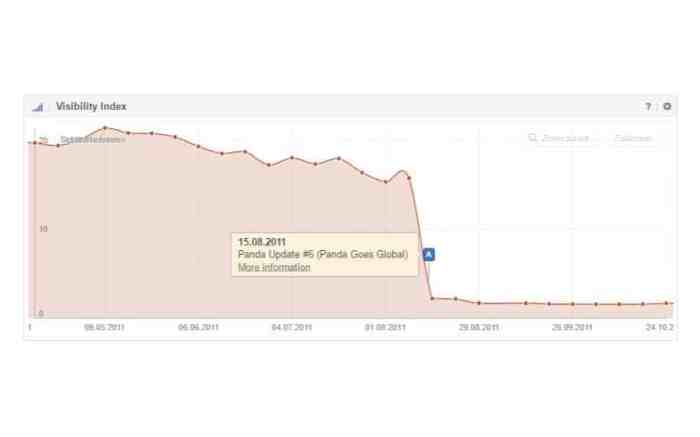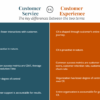Google Panda Update Explained: This update significantly reshaped search results in 2011. It marked a crucial shift in how Google evaluated website quality, moving beyond simple stuffing towards a more nuanced approach. Understanding Panda’s core principles is essential for anyone managing a website or content strategy in today’s digital landscape. This comprehensive guide explores the update’s impact, core principles, and its enduring relevance to modern .
The update aimed to deliver more relevant and trustworthy results to users. It focused on website quality, structure, and user experience. Understanding these factors is key to avoiding penalties and improving search rankings. The initial impact was substantial, leading to both gains and losses for various websites depending on their adherence to Google’s quality guidelines.
Introduction to Google Panda Update
The Google Panda update, released in 2011, was a significant shift in how Google ranked websites in search results. It aimed to combat the proliferation of low-quality, spammy content that was diluting the user experience. This update represented a crucial step in Google’s ongoing evolution towards providing users with more relevant and trustworthy information.The update’s initial impact was profound, leading to significant changes in search rankings for many websites.
Sites that had previously relied on manipulative tactics to improve their search engine visibility found their rankings plummeting. Conversely, high-quality websites with well-written, original content saw a corresponding increase in visibility. This dramatic shift highlighted the growing importance of content quality in the digital landscape.
The Goal of the Panda Update
The primary objective behind the Google Panda update was to improve the quality of search results. Google recognized that the increasing presence of low-quality, thin content and manipulative strategies was negatively affecting the overall user experience. This directly impacted Google’s core mission of providing users with the most relevant and useful information.
Historical Context of the Update
The Panda update was a pivotal moment in the evolution of search algorithms. Prior to Panda, Google’s primary ranking signals were focused on factors like density and link popularity. While these factors played a role, they weren’t sufficient to identify high-quality content. The Panda update introduced a more nuanced approach, placing greater emphasis on factors like content quality, originality, and user engagement.
This shift marked a move away from purely technical practices towards a more holistic understanding of website value.
Impact on Search Results
The Panda update significantly altered search results. Websites previously ranking highly for specific s, but lacking substantial, original content, experienced a decline in rankings. Conversely, websites with high-quality, original content and a clear focus on providing valuable information experienced improved rankings. This emphasis on quality content over quantity had a notable effect on the online landscape, incentivizing website owners to create valuable content.
Evolution of Search Algorithms
The Panda update is part of a broader trend in search engine algorithm evolution. Initially, search engines focused primarily on technical aspects of websites. Over time, algorithms evolved to incorporate more complex factors, including user experience and content quality. The Panda update was a crucial step in this progression, moving beyond superficial factors and recognizing the value of high-quality content.
Understanding Panda’s Core Principles
The Google Panda update, a significant turning point in search engine optimization (), aimed to improve the quality of search results by penalizing websites deemed to be of low quality. This wasn’t a simple algorithm tweak; it represented a fundamental shift in Google’s approach to ranking websites, prioritizing user experience and high-quality content over manipulative tactics.Panda’s core principle revolved around rewarding websites that offered valuable, helpful content to users and penalizing those that prioritized stuffing, thin content, or other deceptive practices.
It emphasized a user-centric approach to website evaluation, recognizing that a high-quality website should cater to the needs and expectations of its visitors.
High-Quality Content
High-quality content is the cornerstone of the Panda update. It’s not just about density or word count. Google, through Panda, began prioritizing websites with well-researched, original, informative, and engaging content that satisfied user search intent. This meant content that answered user questions thoroughly, provided valuable insights, and went beyond superficial descriptions. Content creators had to focus on producing comprehensive and in-depth articles, rather than simply cramming s into thin content.
Website Quality Evaluation
Panda evaluated website quality through a multifaceted approach. Google’s algorithms looked at various factors beyond just content. These factors included the website’s overall structure, the presence of plagiarism, and the presence of user-generated content. The algorithms analyzed the website’s content to assess its originality, depth, and relevance to user queries. Sites that were repetitive, thin, or lacked a focus on providing value were penalized.
Google was trying to weed out content farms and websites that focused solely on generating traffic rather than offering value to users. A website’s backlink profile was also considered, looking for unnatural links that might be indicative of manipulative practices. This meant that website owners needed to build quality links that reflected the value of their content, rather than resorting to artificial link building schemes.
Website Structure and User Experience
A well-structured website, easily navigable and user-friendly, played a crucial role in the Panda update. Google’s algorithms considered the website’s site architecture, internal linking structure, and the overall user experience. Websites with clear navigation, intuitive design, and fast loading times were rewarded. The website should load quickly and be easy to use, mimicking a good user experience.
This ensured that users could easily find the information they were seeking, and the site should be structured in a way that allowed Google’s crawlers to easily index the content. A poor user experience, indicated by high bounce rates, slow loading times, and confusing navigation, would lead to lower rankings. Websites needed to focus on delivering a seamless and enjoyable experience for visitors, making it easier for them to find what they needed.
Understanding Google Panda’s impact on SEO involves looking at more than just keyword stuffing. A key aspect is recognizing the importance of high-quality backlinks. These links, especially those with the correct attributes like those described in google nofollow link attributes , help Google assess the trustworthiness and relevance of a website. Ultimately, avoiding manipulative link schemes and focusing on genuine, valuable content remains crucial to navigating the Panda update effectively.
Panda’s Impact on Websites

The Google Panda update, rolled out in 2011, significantly reshaped the online landscape. It marked a crucial shift in Google’s algorithm, prioritizing high-quality content and penalizing websites that employed manipulative tactics. This update wasn’t just another algorithm tweak; it was a paradigm shift, forcing websites to focus on user experience and genuine value.This shift had profound consequences for websites, both positive and negative.
Understanding Panda’s impact on different types of websites, from small blogs to large e-commerce stores, is crucial for anyone involved in or website management.
Websites Benefiting from Panda’s Principles
Panda’s emphasis on high-quality content, user experience, and authoritative information empowered websites that genuinely catered to their target audience. These sites often saw significant improvements in organic search rankings, attracting more organic traffic and leading to increased visibility and revenue. Examples included blogs focused on in-depth reviews, news websites presenting well-researched articles, and e-commerce stores with meticulous product descriptions and high-quality images.
Understanding Google’s Panda update is crucial for SEO success. Essentially, it’s about rewarding high-quality content and penalizing low-quality sites. To ensure your brand maintains a strong online presence, it’s vital to ask your SEO C-suite to support brand-based SEO strategies. This crucial step will directly impact how Google views your site, ultimately improving your chances of a positive response to Panda updates.
Ultimately, a solid understanding of these factors ensures your website stays relevant and visible in the search results.
These websites consistently provided value to users, making them more attractive to Google’s algorithm.
Consequences for Non-Compliant Websites
Websites that failed to adapt to Panda’s principles faced significant setbacks. Sites using stuffing, low-quality content, and thin content suffered a decline in organic search rankings. This often led to a reduction in organic traffic, impacting their ability to attract potential customers and generate revenue. Many sites that relied heavily on automated content generation or copied content from other sources found themselves penalized.
These practices, once common, became less effective, leading to a dramatic decrease in their visibility in search results.
Long-Term Effects on Strategies
The Panda update ushered in a new era of strategies. Websites had to focus on producing high-quality content that satisfied user intent and provided value. This shift emphasized long-form content, in-depth analysis, and original research. The update also highlighted the importance of authoritative sources and backlinks from reputable websites. professionals needed to adapt their strategies, moving away from short-term, manipulative tactics to a more sustainable and user-centric approach.
Impact on Organic Search Rankings
Panda’s influence on organic search rankings was profound. Websites that met the quality guidelines experienced a surge in rankings, while those that didn’t saw a significant drop. The update underscored the need for high-quality content as a primary ranking factor. This change forced website owners to reassess their content strategies, focusing on value and user experience over simply maximizing density.
This resulted in a long-term shift towards a more sustainable and ethical approach to .
Panda’s Influence on Content Creation: Google Panda Update Explained
The Google Panda update significantly altered the landscape of online content. It moved the focus away from simply accumulating content to prioritizing high-quality, user-centric material. This shift forced website owners to reassess their strategies and adapt to a new set of criteria for success.Panda’s impact wasn’t just about penalizing low-quality content; it was about rewarding sites that provided valuable, informative, and engaging experiences for users.
This led to a crucial evolution in content creation strategies, emphasizing originality, depth, and relevance.
Types of Content That Performed Well Post-Panda
The Panda update highlighted the importance of creating content that truly benefited users. Sites that focused on in-depth, well-researched articles, comprehensive guides, and insightful analyses saw improved rankings. User experience was paramount, meaning content that was easy to read, well-structured, and free of grammatical errors or factual inaccuracies was favoured.
- In-depth articles: These articles went beyond superficial summaries and delved into the subject matter, offering comprehensive explanations and valuable insights. Think of articles that break down complex topics, provide detailed how-to guides, or explore various perspectives on a given issue.
- Original research and analysis: Sites that conducted original research and presented unique analyses of information saw a boost. This type of content demonstrated expertise and provided unique value to readers.
- High-quality visuals: Including relevant images, infographics, videos, or other multimedia elements enhanced the user experience and provided additional value. Visuals improved comprehension and engagement, further reinforcing the quality of the content.
Types of Content That Suffered After Panda
Panda’s impact extended to penalizing content that lacked quality and value. Sites relying on thin, copied content, poorly written material, or spammy tactics saw their rankings suffer.
- Thin content: Content that was too short, lacked substance, or failed to provide meaningful information to users was penalized. This often included articles that were little more than a few sentences or relied on repetitive, shallow information.
- Copied content: Plagiarism and duplicate content from other websites negatively impacted rankings. Sites that failed to create original work suffered significant drops in visibility.
- Poorly written content: Grammatical errors, typos, and incoherent writing contributed to a poor user experience. This negatively impacted rankings and user engagement.
- Spammy content: Content that employed manipulative tactics like stuffing or excessive use of irrelevant s was heavily penalized. This ensured that search results were more relevant to user queries.
Influence on Content Strategies
The Panda update fundamentally shifted content strategies from quantity to quality. Websites had to adapt their approach, focusing on creating content that resonated with their target audience and provided real value.
- Focus on user needs: Content creators began to prioritize user needs and interests, researching what topics were relevant and sought after by their target audience. They shifted from creating content for search engines to creating content for people.
- Investment in quality: Websites invested more resources in producing high-quality content. This involved hiring writers with expertise, fact-checking information thoroughly, and optimizing for user experience.
- Original research and analysis: Websites began conducting their own research and producing original analyses, providing unique perspectives and valuable insights that differentiated them from competitors.
Importance of High-Quality, Original Content
The Panda update reinforced the importance of original, high-quality content. This emphasis on user experience and value drove a paradigm shift in the online world.
“High-quality, original content is not just a strategy, it’s a necessity for long-term success in the digital landscape.”
Panda’s Relation to Other Google Updates
The Google Panda update, while impactful in its own right, wasn’t an isolated event. It existed within a larger context of Google’s evolving search algorithm. Understanding Panda’s relationship with other updates, particularly Penguin, reveals a crucial part of Google’s approach to quality and relevance in search results. This analysis illuminates how Panda influenced future algorithm developments and ultimately impacted strategies.Panda, fundamentally, focused on website quality.
Other updates, like Penguin, tackled different aspects of search result manipulation. Recognizing these distinctions and overlaps helps us appreciate the comprehensive nature of Google’s search engine improvement initiatives.
Comparison with Other Google Updates, Particularly Penguin
Panda and Penguin, though both aimed at improving search quality, targeted different facets of website optimization. Panda evaluated the overall quality of a website’s content and structure, while Penguin addressed the issue of manipulative link building practices. This differentiation is key to understanding how they interacted and influenced each other. For instance, a website could have high-quality content (Panda-friendly) but be penalized by Penguin if its link profile was deemed artificially inflated.
This shows that Google was working to combat various forms of manipulation, rather than solely focusing on one aspect.
Influence on Future Google Updates
Panda’s emphasis on high-quality content laid the groundwork for future updates. Its focus on factors like content freshness, depth, and originality influenced the development of subsequent algorithms, shaping a broader approach to quality signals. Panda helped establish the principle that search results should reflect comprehensive and valuable information, setting a precedent for later updates that further refined this idea.
This is evidenced by updates focusing on mobile-friendliness, which builds upon the core idea of user experience, a key aspect Panda addressed.
Impact on Search Engine Optimization Strategies
The introduction of Panda and other updates forced a significant shift in strategies. professionals needed to move away from stuffing and low-quality content creation towards focusing on creating valuable, engaging content that benefited users. This meant a shift from short-term gains to long-term, sustainable strategies that focused on creating high-quality content for the benefit of users.
Understanding Google’s Panda update is crucial for any online business, especially if you’re focusing on SEO. It’s all about quality content, right? This directly impacts your website’s ranking. Fortunately, strong personal finance skills are also key to success as a solopreneur. Knowing how to manage your finances effectively, like learning about personal finance for juicy solopreneurs , can help you allocate resources wisely for content creation and marketing.
This, in turn, helps your website stay ahead of the game in Google’s ever-changing algorithm, just like the Panda update.
This, in turn, encouraged a better understanding of user intent and search intent.
Connection to Google’s Broader Mission
Panda, along with other updates, directly contributes to Google’s fundamental mission of providing relevant and useful search results. By penalizing low-quality content and rewarding high-quality websites, Google aims to deliver search results that meet user needs and expectations. This approach is essential for maintaining the trust and credibility of the search engine. The continual improvement of algorithms ensures that users are served with relevant and trustworthy information, which is a direct reflection of Google’s commitment to delivering valuable results.
Practical Application of Panda’s Principles
The Google Panda update fundamentally shifted the landscape, prioritizing high-quality websites over those with low-quality content. Understanding and applying Panda’s principles isn’t about memorizing s; it’s about creating a valuable online experience for users. This involves focusing on providing comprehensive, helpful, and authoritative content.Panda’s core principles revolve around rewarding websites that offer genuine value to users. It penalizes websites with thin, low-quality content, manipulative tactics, and poor user experience.
This shift necessitates a proactive approach to website optimization, moving beyond superficial stuffing and toward genuine content creation.
Website Quality Evaluation Checklist
This checklist helps assess your website’s alignment with Panda’s quality standards. Consistent adherence to these principles ensures your site remains competitive in the search results.
- Content Depth and Originality: Does the content provide in-depth information and original insights? Is it genuinely helpful to the reader, or merely a rehash of existing information?
- User Experience (UX): Is the website easy to navigate? Are the pages well-structured and visually appealing? Does the website load quickly, and is it accessible across different devices?
- Accuracy and Authority: Is the information presented accurate and supported by credible sources? Does the content demonstrate expertise in the subject matter? Are sources clearly cited?
- Thin Content Assessment: Are any pages excessively short or lacking sufficient detail to address the user’s query? Are there any indications of scraping content or republishing existing material without substantial original contribution?
- Website Structure and Navigation: Is the website’s structure logical and intuitive, allowing users to easily find the information they need? Are the internal links relevant and helpful to users?
Improving Website Content Based on Panda
This table illustrates how to enhance website content to meet Panda’s focus on high-quality information.
| Panda Focus Area | Current Website Content | Improved Website Content |
|---|---|---|
| Comprehensive Information | Short, superficial articles. | In-depth articles addressing all aspects of the topic. |
| Originality | Copied content from other websites. | Original research, analysis, and insights. |
| Accuracy | Inaccurate or misleading information. | Fact-checked and verified information from reliable sources. |
| User Intent | Content irrelevant to user queries. | Content directly addressing the user’s needs and questions. |
| Value Addition | Content lacking practical value or insights. | Content providing actionable advice, valuable tools, or new perspectives. |
Enhancing Website Structure for Panda Compliance
A well-structured website aids user navigation and signals to search engines that the site is organized and provides value.
- Logical Site Architecture: Create a clear hierarchy for your website’s content, making it easy for users and search engines to find information. Group related pages together, and use a logical navigation system.
- Internal Linking Strategy: Create a network of internal links that guide users to related content within your website. This helps search engines understand the relationships between pages.
- Mobile Friendliness: Ensure your website is responsive and easily accessible across various devices, including mobile phones and tablets.
- Page Speed Optimization: Optimize website loading speed. Slow loading times can negatively impact user experience and search rankings.
Panda’s Key Quality Factors (Infographic)
This infographic visually represents the key factors that Panda considers. The core focus is on user satisfaction, and providing comprehensive, original, and authoritative content.
Panda’s Impact on Search Engine Optimization ()
The Google Panda update fundamentally reshaped the landscape, moving away from -stuffed content and towards a focus on high-quality, user-centric websites. This shift forced SEOs to re-evaluate their strategies, emphasizing genuine value over superficial tactics. The update’s core principle—rewarding sites offering valuable content—had a significant impact on how strategies evolved.The Panda update significantly altered strategies by prioritizing user experience and content quality over stuffing and link building.
It demanded a focus on creating content that was not only optimized for search engines but also relevant and engaging for human readers. This shift in focus required a reevaluation of existing practices and a move towards more holistic approaches.
Adapting Strategies to the Panda Update
The Panda update forced SEOs to transition from a purely technical approach to a more content-focused strategy. This meant moving beyond stuffing and superficial optimization to creating genuinely valuable content that met user needs. This involved in-depth research on target s and topics, coupled with a strong understanding of the target audience.
Techniques to Avoid Panda Penalties
Panda penalties could be avoided by focusing on several key areas. Creating high-quality, original content that addressed user needs was paramount. Thin content, copied content, and content lacking depth or relevance were all flagged by Panda. Building a strong website structure with clear navigation and internal linking also proved essential for a positive user experience. Proper use of schema markup to provide structured data about the website’s content was also critical.
Strategies for Improved Website Performance Post-Panda
Several strategies improved website performance after the Panda update. Prioritizing user experience through intuitive navigation and clear calls to action was crucial. Engaging content that addressed user questions and provided valuable information was highly effective. Improving site speed and mobile responsiveness ensured a seamless user experience across all devices. Regularly updating content with fresh, relevant information helped maintain a site’s value and relevance to search engines.
Ongoing Website Maintenance and Quality Checks
The Panda update emphasized the importance of ongoing website maintenance and quality checks. Regularly reviewing content for accuracy, relevance, and completeness was crucial. Monitoring website traffic patterns and user engagement metrics provided insights into user satisfaction and areas for improvement. This ensured the website remained aligned with Google’s evolving quality guidelines and continued to deliver value to users.
This included consistently monitoring backlinks for quality and relevance.
Current Relevance of the Google Panda Update

The Google Panda update, while a significant event in history, wasn’t a one-time fix-all. Its core principles, however, continue to resonate with modern practices. Understanding how Panda influenced content quality and penalized low-quality websites is crucial for any website aiming for top search engine rankings today.Panda’s principles, though implemented years ago, remain fundamentally important in the current landscape.
Modern search engines, including Google, prioritize high-quality, user-centric content. This aligns perfectly with the core tenets of Panda, emphasizing valuable and engaging content over stuffing and other manipulative tactics.
Current Relevance of Panda Principles in Modern Practices, Google panda update explained
Panda’s core principles, emphasizing high-quality content and user experience, are deeply ingrained in current practices. These principles still form the foundation of many strategies, shaping content creation and site architecture. Modern practitioners understand the value of providing useful, informative, and engaging content that resonates with their target audience.
Panda Principles’ Continued Vital Role in Ranking
Panda’s principles remain vital for ranking today because search engines, especially Google, continue to prioritize user experience and high-quality content. Sites that prioritize superficial content, thin content, or content not aligned with user intent are likely to face penalties, just as they did during the Panda era.
Panda’s Influence on Other Search Engines
While not directly replicating the Panda update, other search engines have adopted similar strategies focusing on user experience and quality. These engines recognize the value of high-quality content, leading to a consistent emphasis on factors like content originality, value, and relevance, in order to provide the best possible user experience. The principles behind Panda are reflected in algorithms across the industry.
How to Avoid Content Penalties Today
Avoiding content penalties today requires a multifaceted approach that echoes Panda’s core principles. Prioritizing quality over quantity is paramount. Create content that is original, informative, and provides real value to users. Focus on in-depth, well-researched content. Consider user intent when creating content, answering their questions and addressing their needs.
- Focus on Original Content: Avoid plagiarism and duplicate content. Repurposing existing content is acceptable, but ensuring that the repurposed content remains unique is vital. Create fresh, original content whenever possible, offering unique insights and perspectives.
- Prioritize User Experience: Ensure your website is easy to navigate, loads quickly, and presents information clearly. A positive user experience is critical to ranking highly in search results.
- High-Quality Content is Key: Incorporate thorough research and cite sources where appropriate. Avoid stuffing and other manipulative tactics. Instead, focus on providing comprehensive, informative content that caters to the needs of your target audience.
Closing Summary
In conclusion, the Google Panda update was a pivotal moment in search engine optimization. It highlighted the importance of high-quality content, user experience, and website structure. While the specifics of Panda have evolved, its core principles—prioritizing user experience and quality content—remain vital for modern success. This guide provides a thorough understanding of Panda’s past, present, and future relevance.






